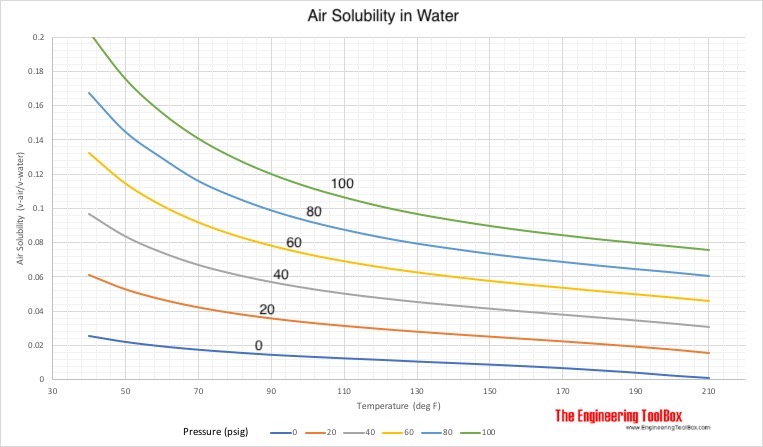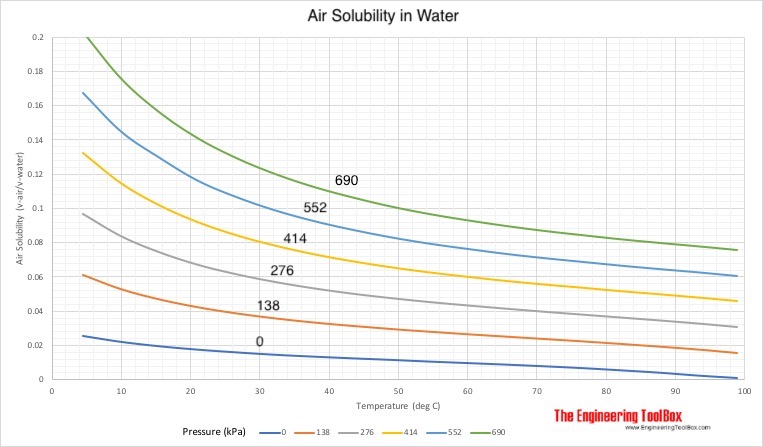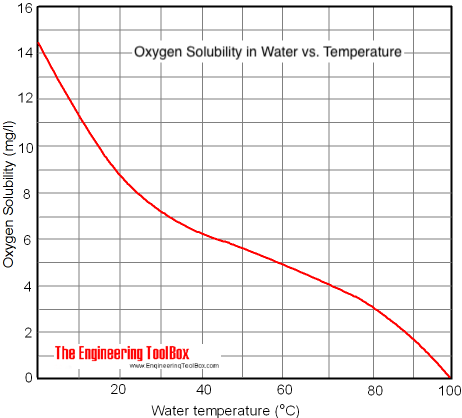Solubility of Air in Water
The amount of air that can be dissolved in water decreases with temperature and increases with pressure.
The amount of air that can be dissolved in water increases with pressure and decreases with temperature.
Deaeration
When fresh water is heated up air bubbles start to form. The water can obviously not hold the dissolved air with increased temperature. At 100 oC (212 oF) water starts to boil - the bubbles are formed by evaporated water or steam. If the water is cooled down and then again reheated, bubbles will not appear until the water starts to boil. The water is deaerated.
Solubility Ratio
Solubility of air in water can be expressed as a solubility ratio:
Sa = ma / mw (1)
where
Sa = solubility ratio
ma = mass of air (lbm, kg)
mw = mass of water (lbm, kg)
Henry's Law
Solubility of air in water follows Henry's Law - "the amount of air dissolved in a fluid is proportional to the pressure in the system" - and can be expressed as:
c = pg / kH (2)
where
c= solubility of dissolved gas
kH= proportionality constant depending on the nature of the gas and the solvent
pg= partial pressure of gas (Pa, psi)
The solubility of oxygen in water is higher than the solubility of nitrogen. Air dissolved in water contains approximately 35.6% oxygen compared to 21% in air.
Solubility of Air in Water
Solubility of air in water - expressed as ratio of absorbed air volume to water volume:
Temperature (oF) | Solubility (vair/vwater) | |||||
|---|---|---|---|---|---|---|
| Gauge Pressure (psig) | ||||||
| 0 | 20 | 40 | 60 | 80 | 100 | |
| 40 | 0.0258 | 0.0613 | 0.0967 | 0.1321 | 0.1676 | 0.2030 |
| 50 | 0.0223 | 0.0529 | 0.0836 | 0.1143 | 0.1449 | 0.1756 |
| 60 | 0.0197 | 0.0469 | 0.0742 | 0.1014 | 0.1296 | 0.1559 |
| 70 | 0.0177 | 0.0423 | 0.0669 | 0.0916 | 0.1162 | 0.1408 |
| 80 | 0.0161 | 0.0387 | 0.0614 | 0.0840 | 0.1067 | 0.1293 |
| 90 | 0.0147 | 0.0358 | 0.0569 | 0.0780 | 0.0990 | 0.1201 |
| 100 | 0.0136 | 0.0334 | 0.0532 | 0.0730 | 0.0928 | 0.1126 |
| 110 | 0.0126 | 0.0314 | 0.0501 | 0.0689 | 0.0877 | 0.1065 |
| 120 | 0.0117 | 0.0296 | 0.0475 | 0.0654 | 0.0833 | 0.1012 |
| 130 | 0.0107 | 0.0280 | 0.0452 | 0.0624 | 0.0796 | 0.0968 |
| 140 | 0.0098 | 0.0265 | 0.0432 | 0.0598 | 0.0765 | 0.0931 |
| 150 | 0.0089 | 0.0251 | 0.0413 | 0.0574 | 0.0736 | 0.0898 |
| 160 | 0.0079 | 0.0237 | 0.0395 | 0.0553 | 0.0711 | 0.0869 |
| 170 | 0.0068 | 0.0223 | 0.0378 | 0.0534 | 0.0689 | 0.0844 |
| 180 | 0.0055 | 0.0208 | 0.0361 | 0.0514 | 0.0667 | 0.0820 |
| 190 | 0.0041 | 0.0192 | 0.0344 | 0.0496 | 0.0647 | 0.0799 |
| 200 | 0.0024 | 0.0175 | 0.0326 | 0.0477 | 0.0628 | 0.0779 |
| 210 | 0.0004 | 0.0155 | 0.0306 | 0.0457 | 0.0607 | 0.0758 |


Example - Air Dissolved in Water
The amount of air dissolved in water - mass of air to volume/mass of water - can be calculated with Henry's law.
Henry Law's Constants at a system temperature of 25oC (77oF)
- Oxygen - O2 : 756.7 atm/(mol/litre)
- Nitrogen - N2 : 1600 atm/(mol/litre)
Molar Weights
- Oxygen - O2 : 31.9988 g/mol
- Nitrogen - N2 : 28.0134 g/mol
Partial fraction in Air
- Oxygen - O2 : ~ 0.21
- Nitrogen - N2 : ~ 0.79
Oxygen dissolved in the Water at atmospheric pressure can be calculated as:
co = (1 atm) 0.21 / (756.7 atm/(mol/litre)) (31.9988 g/mol)
=0.0089 g/litre
~ 0.0089 g/kg
Nitrogen dissolved in the Water at atmospheric pressure can be calculated as:
cn = (1 atm) 0.79 / (1600 atm/(mol/litre)) (28.0134 g/mol)
=0.0138 g/litre
~ 0.0138 g/kg
Since air mainly consists of Nitrogen and Oxygen - the air dissolved in the water can be calculated as:
ca =(0.0089 g/litre) + (0.0138 g/litre)
= 0.0227 g/litre
~ 0.023 g/kg
Calculating the air dissolved in water for some other pressures at temperature 25oC (77oF) can be summarized to:
| Pressure, abs (atm) | 1 | 2 | 3 | 4 | 5 | 6 |
| Dissolved Air in Water (25oC) (g/kg) | 0.023 | 0.045 | 0.068 | 0.091 | 0.114 | 0.136 |
Dissolved Oxygen in Fresh Water

Deaeration
For maximum deaeration the water should be heated up to 212 oF (100 oC) at atmospheric pressure. This is common in steam systems where fresh water is supplied to the system through a heated deaeration tower on the top of the condensate receiver tank.
It is also common to install deaeration devices on the hot sides of heat exchangers in heating distribution systems to force the dissolved air out of the system.
Note! Since the maximum deaeration is limited by the minimum static pressure and maximum temperature in the system - the best deaeration result is achieved in positions at the hottest and highest levels of the systems - and/or at the suction side of pumps.
Related Topics
-
Material Properties
Properties of gases, fluids and solids. Densities, specific heats, viscosities and more.
Related Documents
-
Air - Composition and Molecular Weight
Dry air is a mechanical mixture of nitrogen, oxygen, argon and several other gases in minor amounts. -
Air - Density vs. Pressure and Temperature
Air density at pressure ranging 1 to 10 000 bara (14.5 - 145000 psi) and constant selected temperatures. -
Air - Density, Specific Weight and Thermal Expansion Coefficient vs. Temperature and Pressure
Online calculator, figures and tables showing density, specific weight and thermal expansion coefficients of air at temperatures ranging -100 to 1600 °C (-140 to 2900 °F) at atmospheric and higher pressure - Imperial and SI Units. -
Air - Diffusion Coefficients of Gases in Excess of Air
Diffusion coefficients (D12) for gases in large excess of air at temperatures ranging 0 - 400 °C. -
Air - Dynamic and Kinematic Viscosity
Online calculator, figures and tables with dynamic (absolute) and kinematic viscosity for air at temperatures ranging -100 to 1600°C (-150 to 2900°F) and at pressures ranging 1 to 10 000 bara (14.5 - 145000 psia) - SI and Imperial Units. -
Air - Prandtl Number
Prandtl number for air vs. temperature and pressure. -
Air - Properties at Gas-Liquid Equilibrium Conditions
Properties of air change along the boiling and condensation curves (temperature and pressure between triple point and critical point conditions). An air phase diagram included. -
Air - Specific Heat vs. Pressure at Constant Temperature
Figures and tables with isobaric (Cp) and isochoric (Cv) specific heat of air at constant temperature and pressure ranging 0.01 to 10000 bara. -
Air - Thermal Conductivity vs. Temperature and Pressure
Online calculator with figures and tables showing air thermal conductivity vs. temperature and pressure. SI and imperial units. -
Air - Thermal Diffusivity vs. Temperature and Pressure
Figures and tables withdry air thermal diffusivity vs. temperarure and pressure. SI and Imperial units. -
Boiler Water - Total Dissolved Solids (TDS)
Impurities from the feedwater will concentrate in the boiling water. -
Feed Water Treatment to Avoid Corrosion
Make-up water to steam boilers should be treated with oxygen scavengers to avoid serious corrosion problems. -
Oxygen - Density and Specific Weight vs. Temperature and Pressure
Online calculator, figures and tables showing density and specific weight of oxygen, O2, at varying temperature and pressure - Imperial and SI Units. -
Oxygen - Dynamic and Kinematic Viscosity vs. Temperature and Pressure
Online calculator, figures and tables showing dynamic and kinematic viscosity of oxygen, O2, at varying temperature and pressure - Imperial and SI Units. -
Oxygen - Solubility in Fresh and Sea Water vs. Temperature
Solubility of oxygen in equilibration with air in fresh water and seawater (salt water) - pressures ranging 1 - 4 bar abs. -
Oxygen - Thermophysical properties
Chemical, Physical and Thermal Properties of Oxygen - O2. -
Oxygen Gas - Specific Heat vs. Temperature
Specific heat of Oxygen Gas - O2 - at temperatures ranging 175 - 6000 K.




